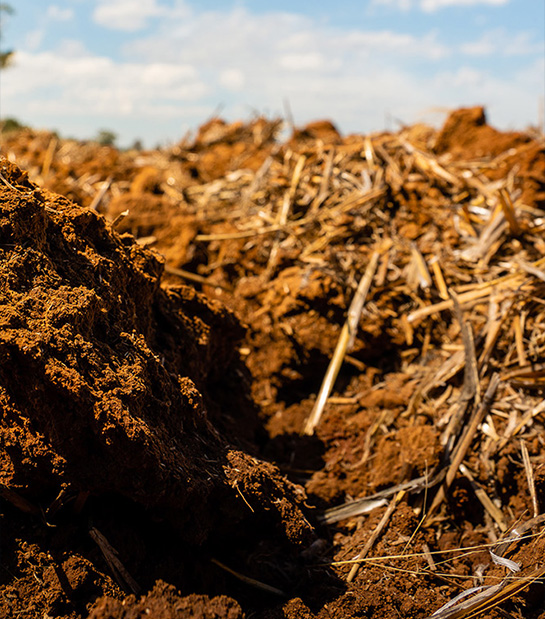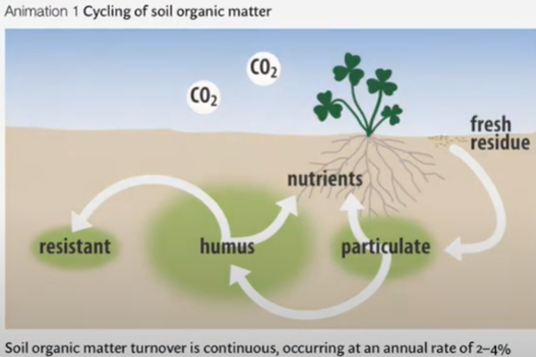A fact sheet to support the Soil CRC’s ‘Demystifying soil organic matter’ webinar, delivered as part of our ‘Building technical capacity for improved soil management’ webinar series.
In this webinar, Murdoch University Professor, Dr Richard Bell, discusses the importance of organic matter in soil, including:
- its role in ecosystem services
- the cycling of soil organic matter
- understanding the carbon to nitrogen ratio
- managing and monitoring soil organic matter.
Information is sourced from the Soil Quality series of ebooks, specifically book number three on soil organic matter by Francis Hoyle and Daniel Murphy.
Why is soil organic matter important?
Soil organic matter plays a critical role in soil ecosystem services and is part of a soil’s natural capital. Organic matter in the soil serves as:
- an energy source for soil microorganisms, including bacteria, fungi, and soil fauna. It is crucial for their survival and functioning.
- a reservoir for essential nutrients like nitrogen, sulphur, and even phosphorus, contributing to soil resilience and its ability to withstand stressors like droughts.
Variations in soil organic matter
There are significant variations in organic matter levels, particularly in relation to rainfall. In Southwest Australia, organic carbon levels vary with rainfall, with higher levels near the coast. The potential for carbon storage is greater in wetter areas compared to drier, northern regions. It is affected by soil texture, especially clay content, and climate, which influences both inputs and losses of organic matter.
Building organic matter
Building organic matter in soils is a gradual process but offers many benefits, both biologically and chemically. To maintain organic matter levels in soil, we must add carbon continuously, as natural decomposition processes continually break it down. Increasing organic matter content can enhance water retention in soils, benefiting crop production, but significant increases may require substantial organic inputs.
The carbon to nitrogen (C to N) ratio in soil organic matter typically ranges from 10 to 12. However, when adding different materials to the soil, such as crop residues with varying C to N ratios, it can temporarily immobilise nitrogen as microorganisms consume available nitrogen during decomposition. This can impact nutrient availability in the soil.
Cycling of organic matter
Most of the soil’s carbon resides in the upper 30 cm, with 60% in the top 10 cm. However, this upper layer is susceptible to erosion and decomposition. Organic matter in soil is a complex mix, including dissolved organic carbon, humus, and particulate matter. Soil organic matter continuously cycles between its living, decomposing, and stable fractions, contributing to soil health and fertility.
Monitoring organic matter
How you monitor soil organic matter depends on your goals. In production systems, regular sampling of uniform areas with multiple cores taken to a consistent depth (e.g., 0-10 cm) is recommended. Quick sample processing and reliable lab analysis are crucial. For carbon sequestration programs, specific guidelines and methodologies are prescribed to measure and validate carbon levels.
To ensure accurate measurement of organic matter in soil, it is important to take multiple samples from a uniform area, standardise the depth, and send the samples to a certified lab quickly, with a recommended sampling frequency of 3 to 5 years.
Optimum organic levels
Determining the optimum organic levels in soil can be challenging, as it depends on various factors like climate, clay content, and management practices. Organic matter is not a single compound but a mix of compounds, and its turnover rate is critical. While increasing organic carbon may be desirable, it’s essential to consider the quality of carbon and its turnover, not just the quantity.
You can measure an increase in soil organic matter, but it may not be significant, which is important to consider when discussing its potential and the need for measurement and validation in carbon offset programs.
Soil management practices matter
Soil management practices can impact carbon stocks in the soil over time, with perennial pastures increasing organic matter content, but measuring this increase accurately requires multiple samples, standardised depth, and frequent sampling.
Soil management practices, such as adding green manure or cover crops, controlling erosion, and incorporating organic amendments, can impact carbon stocks in the soil over time, as shown in various studies (Chapter 5 Managing Soil Organic Matter, Soil Quality ebook 3 Soil Organic Matter).
Soluble nitrogen fertiliser and soil carbon
The relationship between soluble nitrogen fertiliser and soil carbon is complex. Adding soluble nitrogen can stimulate biological activity, potentially leading to faster decomposition of soil carbon. To maintain soil organic matter levels, it’s crucial to balance the inputs and outputs of carbon in the soil, ensuring that carbon inputs, such as organic matter, match or exceed the rate of decomposition.


Source: Soil Quality: 3 Soil Organic Matter eBook, SoilsWest
Further information
- Soil Quality: 3 Soil Organic Matter (Frances Hoyle & Daniel Murphy) – Available on Apple Books
- Soil organic matter in cropping systems (NSW DPI)
- GRDC Guide to managing soil organic matter
- Soil Quality fact sheets
- Compost for soils (Australian Organics Recycling Association)
- Making compost on farm case study (South West NRM)
- Soil Science Australia Smart Soils Resources
Relevant Soil CRC projects
- Project 1.4.006 Assessing the financial impacts of using organic wastes as fertiliser
- Project 3.1.005 Increasing nutrient efficiency with new organic amendments
- Project 3.1.006 Unlocking soil nutrients with organic amendments
Acknowledgement
This webinar was recorded in 2020 as part of the ‘Building technical capacity for improved soil management’ webinar series. It was produced by the Soil CRC and jointly funded through the Australian Government’s National Landcare Program.
Posted Mar 15, 2024

